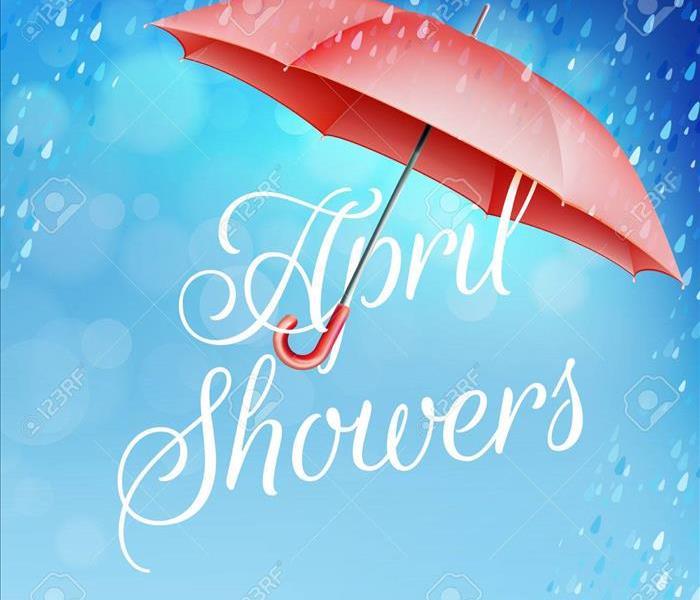Archived Water Damage Blog Posts
What should I do when Water Damage happens??
7/5/2024 (Permalink)
 We can help with Water Damage
We can help with Water Damage
Water damage can be a homeowner’s worst nightmare. Whether it’s from a burst pipe, a leaky roof, or a natural disaster, water damage can cause significant destruction if not addressed promptly. Knowing what to do immediately after discovering water damage can make a big difference in minimizing the damage and starting the restoration process. Here’s a step-by-step guide on what you should do when you encounter water damage in your home.
Ensure Safety First
The first and most important step is to ensure the safety of everyone in the home. Water and electricity are a dangerous combination, so if water damage occurs near electrical appliances or outlets, it’s crucial to turn off the power to the affected areas. Avoid using electrical devices in wet areas, and if the water damage is extensive, it may be necessary to shut off the main power supply to the home.
Stop the Water Source
If possible, identify and stop the source of the water to prevent further damage. This might involve shutting off the main water supply valve or fixing a broken pipe. If the water damage is due to a natural disaster or severe weather, you may not be able to stop the water source, but taking this step can significantly reduce the amount of water entering your home.
Remove Valuable Items
Once the immediate danger is addressed, it’s time to move valuables and furniture away from the affected area. This will help prevent additional damage to your belongings. Items such as electronics, important documents, and sentimental items should be prioritized. If possible, move these items to a dry and safe location. For larger items like furniture, placing them on blocks or aluminum foil to keep them off the wet floor can help minimize damage.
Call Professionals
Contacting a professional water restoration service like SERVPRO of BGMH immediately is crucial. Water damage can worsen quickly, and mold can begin to grow within 48 hours. Professional restoration services have the expertise and equipment to handle the situation efficiently and effectively. At SERVPRO of BGMH, we respond quickly to water damage emergencies. Our team uses advanced equipment to remove water and dry out your property, preventing mold growth and further damage.
Document the Damage
While waiting for the professionals to arrive, it’s a good idea to document the damage for insurance purposes. Take photos and videos of the affected areas and any damaged items. This documentation will be helpful when filing an insurance claim and can help ensure you receive the compensation you deserve.
Begin the Drying Process
If it’s safe to do so, you can start the drying process while waiting for professional help to arrive. Use fans, dehumidifiers, and open windows to increase airflow and help dry out the affected areas. However, be cautious not to use electrical appliances in wet areas, and avoid using your HVAC system if the ducts are affected by water.
Work with Your Insurance Company
Contact your insurance company as soon as possible to report the water damage and begin the claims process. Provide them with the documentation you’ve collected and any information about the steps you’ve taken so far. Your insurance company may have specific requirements for the claims process, so it’s important to follow their instructions carefully.
Prevent Future Water Damage
Once the immediate water damage has been addressed, take steps to prevent future incidents. Regular maintenance of your home’s plumbing and roofing can help identify potential issues before they become major problems. Installing a sump pump, using water leak detectors, and ensuring proper drainage around your home can also reduce the risk of water damage.
Why Choose SERVPRO of BGMH?
We understand the urgency of water damage situations. Our team is trained to respond quickly and efficiently to minimize damage and restore your home. We use advanced equipment and techniques to ensure thorough water extraction and drying. Additionally, we offer comprehensive restoration services, including mold remediation and structural repairs.
If you’re facing water damage, don’t hesitate to reach out to us at 270-580-2200. We’re here to help you through every step of the restoration process, providing the support and expertise you need to get your home back to normal. Contact SERVPRO of BGMH today for prompt and professional water restoration services.
Got the Ceiling Drips?
2/15/2023 (Permalink)
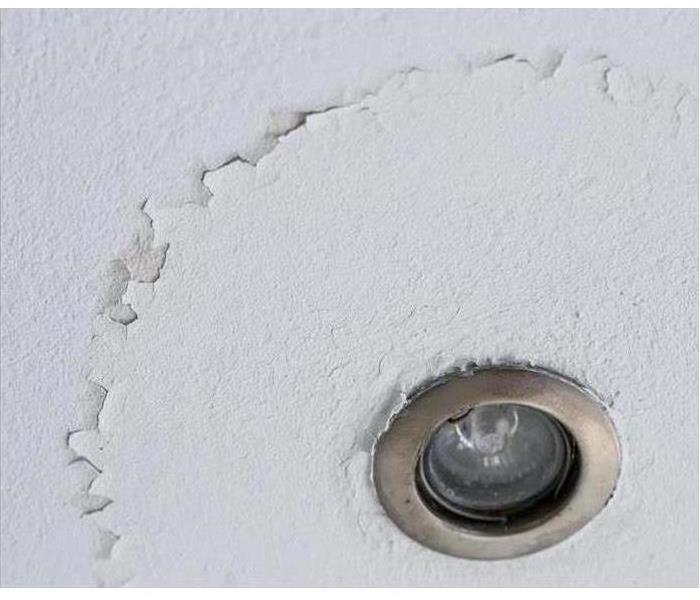
Water dripping from the ceiling is a serious, yet, common problem. Drips in the ceiling turns into water in a light fixture scenario, the situation can quickly become hazardous. Electricity plus water equals a dangerous combination. To ensure your family’s safety, call in a water mitigation team. While you wait for the team to arrive, there are four steps you can take to help get the job done quickly.
1. Utilities
Make sure the electricity, gas and water are turned off to the area affected by the leak. Water can conduct electricity from an active electrical line, and that can become a very dangerous situation as the current flows through the metal parts of the light fixture.
2. Make Everyone Aware
Announce to everyone in your home that there is water in a light fixture. You should probably also let them know the gas, water, and electricity will be turned off for an unknown number of hours.
3. Draining
Ceiling damage from water can sometimes pool and cause a protrusion in your ceiling. If that is true in your case, you may consider draining the area. With a bucket in hand, softly pierce the center of the sagging ceiling bulge with an item like a small wooden dowel. Be prepared for a flood of water from the tiny hole.
4. Cleaning
Not only is it important to remove the water from the floor, but you may find it necessary to keep additional water from hitting your newly cleaned surface. Use a bucket to catch the leaking water if it is still dripping, and place towels around as necessary.
If the leaking water in a light fixture fell onto the carpet, you can make a request that your water mitigation team handle the water removal and disinfecting of the flooring area.
Our Water Loss Process
10/24/2022 (Permalink)
When problems with plumbing causes excessive pooling it requires removal equipment that most homeowners do not own. Whether it's a slow leak or a full-scale burst pipe, the after-effects of crawlspaces, sub floors and carpet pads become saturated by water can cause lasting harm.
The Process of removing water:
First, we use pumps, before moving in with more precise wet/dry vacuums and extraction wands. Our technicians must pass an in depth training program before working in our franchises. Their training allows them to use advanced techniques to make sure moisture is removed and prevent secondary damage from happening.
Floorboards can be difficult to dry, which is why we use flat lay drying techniques. A process by which a sheet is laid on the affected surface and air-circulation is applied. As the sheet inflates, water is drawn out and into the air. We have found this technique to be extremely useful in the removal of moisture from in between floorboards or gaps within your property's structure.
Sometimes carpets are pulled up, pads replaced, and sub floors inspected to ensure proper removal of moisture. Next, we can place rapid air-movers into the affected area. These circulate hot air, evaporating moisture. It is part of a two-step process that guards against the risk of mold or mildew buildup after a leak. The second step is to place humidifiers into the affected area and remove the evaporated moisture from the air.
At the conclusion of service, our technician can remove all equipment as well as any materials that need to be discarded. We then encourage a final walk through in the affected area to show you where work has been carried out, where items have been restored and what needs replacing. At SERVPRO of Breckinridge, Grayson, Meade & Hancock Counties we know replacing items can get expensive, so we work toward restoration rather than a replacement to keep costs as low as possible for our customers.
If you need urgent water removal, do not hesitate to call SERVPRO of Breckinridge, Grayson, Meade & Hancock Counties today! 270-580-2200
What do I do when I have water damage?
2/16/2022 (Permalink)
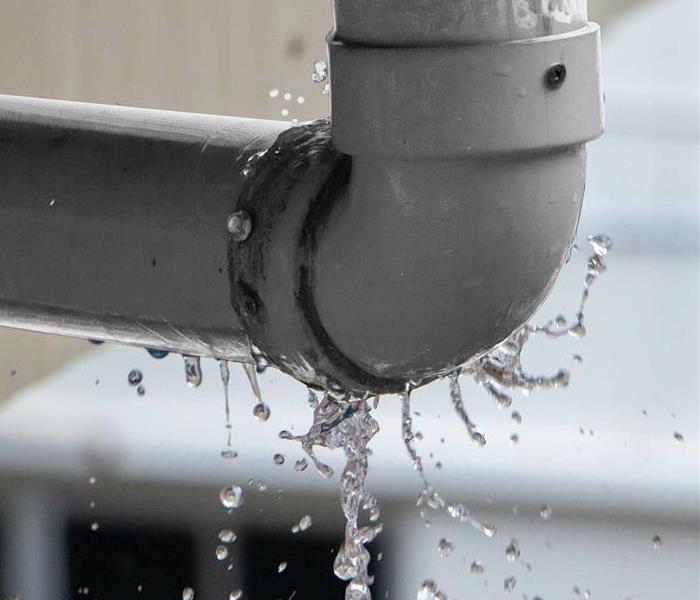 Water damage can come from a plumbing leak. What will you do when you find this? Call SERVPRO!
Water damage can come from a plumbing leak. What will you do when you find this? Call SERVPRO!
Many of us do not know the first steps to take in the event of water damage in our homes. SERVPRO has over 40 years of leadership and training in cleanup and restoration services. SERVPRO has put together a few Do’s and Don’ts to help in the event of water damage in your home.
Water Damage from Clean Water
DO:
- Shut off the source of the water as quickly as possible.
- Turn off any circuit breakers for wet areas of the building when access to the breaker box is safe from electrical shock.
- Remove as much excess water as possible by mopping & blotting.
- Wipe excess water from wood furniture after removing lamps and tabletop items.
- Place aluminum foil or wood blocks between furniture legs and wet carpet.
- Remove any documents, computers and other materials that are valuable or sensitive to moisture.
DON’T:
- Enter rooms with standing water where electrical shock hazards are at risk.
- Enter affected areas if electrical outlets, switches or circuit breakers are exposed to water/
- Leave books, newspapers. Magazines or other colored items on wet carpets or floors to cause staining.
- Leave oriental rugs or other colored rugs on wet wall-to-wall carpets to cause staining.
- Use your household vacuum cleaner to remove excess water. This could cause electrical shock or damage the vacuum cleaner.
- Use TVs or other appliances while standing on wet carpets or floors.
- Turn on ceiling fixtures if the ceilings are wet or enter rooms where ceilings are sagging from retained water
Commercial Cleaners Create a Safer and More Healthy Workspace
10/15/2021 (Permalink)
Safety is a priority for a business owner for their employees and customers. The right janitorial company can play a crucial role in preventing workplace injuries and illnesses. It can also help keep your business in compliant with health and safety regulations. When a customer or employee walk into a facility a key factor to prevent an injury or an illness is to make sure the following items have been done:
Help prevent slips, trips and falls inside and outside your building:
- Parking Lots and Sidewalks – Check for potholes, uneven walkways, broken parking blocks. Properly mark any changes in elevation of walkways. Correctly mark all parking spaces.
- Inside Building: Install non- slip mats in front of doors to wipe wet feet. Place same mats in front of ice machines, sinks and drinking fountains. If there are wet floors, place caution signs.
Proper Lighting and Electrical Components:
- Make sure all emergency lighting is installed and checked regularly to make sure they are working. All exit signs are always visible and illuminated.
- In bathrooms and kitchens should have ground fault breakers. Make sure workstation outlets are not overloaded which could cause a fire.
Cleanliness of Workspace:
- Daily disinfecting of bathrooms and cafeterias to stop cross-contamination of the spreading of germs from colds and flu.
Emergency Fire Equipment:
- Make sure all fire alarms, smoke detectors and carbon monoxide detectors are hardwired with a battery backup and are checked on a regular basis.
- Check fire escapes to make sure they are functioning and clear of any objects or debris.
- Sprinkler System is up to code and has been inspected and records kept on file.
- Portable Fire Extinguishers should be kept on each floor of the building and easily accessible. Teach each employee how to properly use an extinguisher. The National Fire Prevention Association (NFPA) suggests remembering the word PASS: Pull the pin. Hold the nozzle pointing away from you and release the locking mechanism. Aim low. Point the extinguisher at the base of the fire. Squeeze the lever slowly and evenly. Sweep the nozzle from side-to-side.
A safe workspace keeps employees productive, attract customers, and protects your business from potential lawsuits. Keeping employees and customers safe isn’t just the right thing to do, it’s also important for your business.
Looking for a commercial janitorial company, please call SERVPRO of Breckinridge, Grayson, Meade & Hancock Counties at 270-580-2200
How to Locate a Bathtub or Shower Leak
9/8/2021 (Permalink)
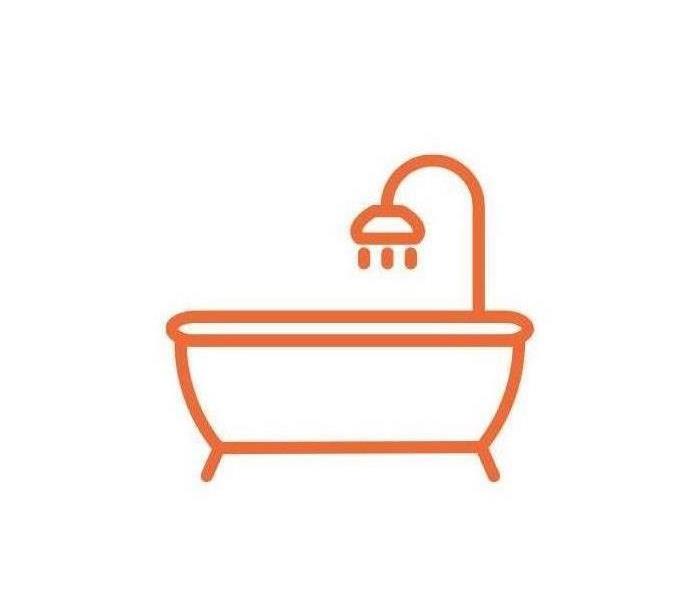 If you suspect water damage in your property, contact SERVPRO
If you suspect water damage in your property, contact SERVPRO
Though some water leaks throughout your central Kentucky, home can be easy to spot, there're a vast amount of others that require more than a casual glance. A shower or bathtub leak, for example, can fall into the latter category, as they're a variety of places for leaks to emerge from in these areas. If you need help identifying a shower water leak, read how to locate one without much hassle effectively. Once the source has been identified, contacting a trained water restoration team can ensure your home removes any water damage, as well.
Check the Common Sources First
Before tearing into the tile work or uprooting your tub, it pays to investigate the more apparent areas first. After a shower, inspect familiar sources such as the:
- Showerhead face,
- The O-ring between the showerhead and arm,
- Faucet handles, and the areas surrounding them, or
- Caulking at the base or surrounding of a shower/tub combination.
Leak issues are generally noticeable in these spaces and can be detected by sight after running water through your shower.
Have a Professional Inspect Your Shower Pan
A shower pan leak is another usual spot for an issue, especially in tiled shower designs. These leaks can start from the pan being too old and faulty or merely due to a new one being installed incorrectly. Therefore, it pays to have someone inspect this space as a potential cause for any shower or bathtub leak.
Determine the Severity of the Issue by Searching the Levels Below
There's no more precise indication of a bad water leak within your shower floor than through the ceiling or flooring directly below the shower itself. Look for signs of water damage or condensation on the ceiling beneath a second-story shower or throughout your crawl space below a first-floor shower.
When eliminating a bathroom leak in your home follow any of these efficient methods for a quick solo inspection before contacting a professional for further assistance. For additional questions, contact SERVPRO of Breckinridge, Grayson, Meade and Hancock Counties.
4 Easy Tips to Prevent Water Damage
9/8/2021 (Permalink)
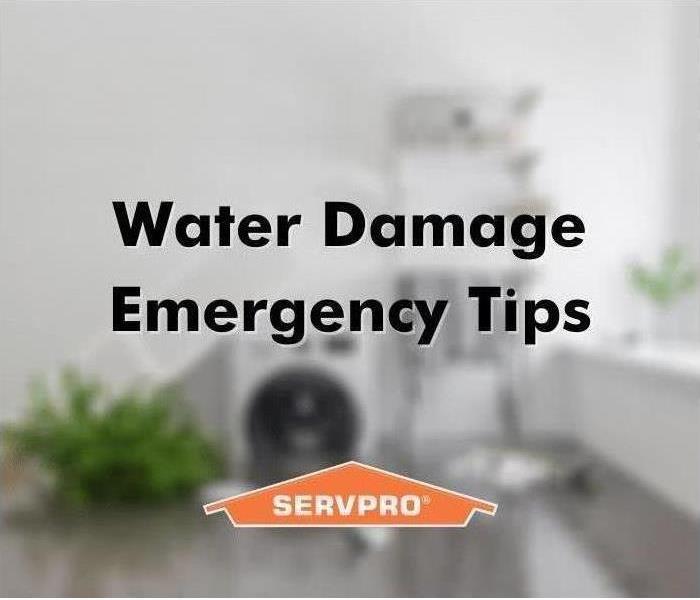 Follow these tips to prevent water damage in your Kentucky property.
Follow these tips to prevent water damage in your Kentucky property.
With the school year coming to an end, this means kids will be “flooding” into homes this summer. View these suggestions from SERVPRO of Breckinridge, Grayson, Meade and Hancock Counties for preventing water damage while your kids are home.
- Be Careful Where You Plant.
Some plants and trees, like weeping willows, have pretty invasive roots. If you’re not careful, they’ll grow right into your sprinkler system, drainage field, pipes, and septic tanks. Plan before you plant to keep roots away from any water lines.
- Clean Out Roof Gutters.
On a rainy day, a clogged gutter can send water spilling into your home’s foundation, through the roof, or down to your basement. That could cause some severe water damage! So next time you’re doing some seasonal cleaning, make sure those gutters are clean. If your gutters are too high, be safe, and get a professional to check them.
- Use a Drain Snake Instead of Unclogging Chemicals.
Most folks don’t realize these chemicals are eating away at their pipes (and they might not be too good for you either). If you rely on them a lot, you could be setting yourself up for leaks. That’s why owning a drain snake is an excellent solution to clear away clogs. They’re pretty inexpensive, you can get them at your local hardware store, and they can cut through most any clog you’ll have without damaging pipes or making your eyes red and teary.
- Never Pour Grease Down Your Sink.
It doesn’t matter if you flush it with hot or cold water; grease can still cling to your pipes and could even cause some severe damage and blockage. The safest thing to do is pour your grease in an empty can and either let it sit or put it in the refrigerator. Once it hardens, you can toss it in the trash and get rid of it. Done and done. However, we know that water and flooding emergencies can happen any time, so we’re ready 24 hours a day, 7 days a week – including holidays.
How Do I Get Water Out of My Kitchen?
4/8/2021 (Permalink)
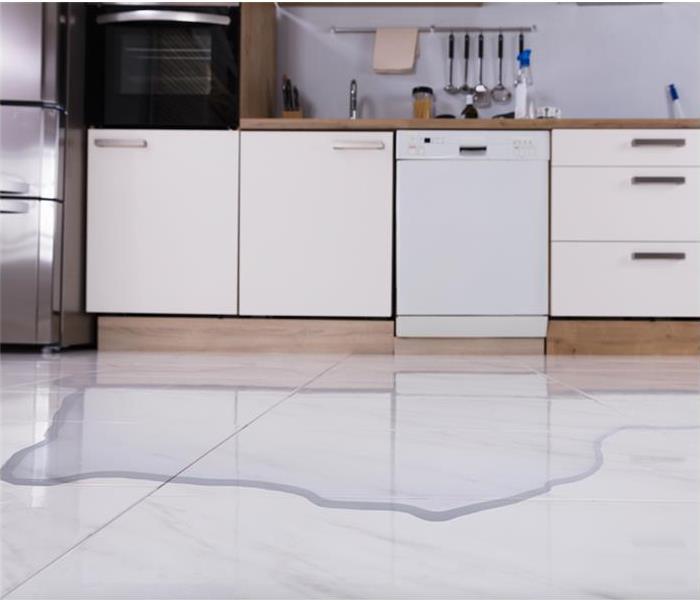 When you are surprised by water damage in the morning as you are getting ready to go to work, please remember that SERVPRO is waiting to help you out.
When you are surprised by water damage in the morning as you are getting ready to go to work, please remember that SERVPRO is waiting to help you out.
Bring in a SERVPRO Water Removal Team to preserve your home
The water line leading into your refrigerator broke down about 12:30 am on Saturday. You didn’t notice it, of course, until you got up for coffee eight hours later. Then you feel it between your toes as you splash your way around, trying to find the leak and turn off the water.
What are Water Removal Technicians going to do when they get here?
First, they are going to isolate the leak and turn it off or block it if you have not been able to do so. Next, team members use a pump or an extractor for physical water removal from your kitchen, depending on how deep it might be. Once they accomplish that, other team members use tools like long-handled squeegees to push any trace water off the surface, allowing natural evaporation to begin, releasing water into the air.
Next, one of our technicians performs a visual inspection and uses a thermal camera to examine the sub-floor. She does this to determine a couple of key issues:
- Is there a crack or split in the kitchen flooring?
- If yes, did it allow water to spill into the sub-floor area?
If the answer is yes to either question, our technicians can take positive action. Each team has the skills to make repairs to linoleum and other floor coverings, or remove and replace damaged flooring so it looks exactly as before, or better than it was before the spill. Before replacement, they go into the sub-floor and use commercial grade water pumps with flexible hoses to remove water.
Once everything is back in place, SERVPRO technicians then place a humidifier in the kitchen. This device draws the excess water in the air and off surfaces to lower the interior humidity and completely return the home to its normal condition.
Our water removal team at SERVPRO is prepared 24/7 to return every home to a dry, safe condition here and in our nearby communities of Breckinridge, Grayson, Meade and Hancock Counties. Call our office today at (270) 580-2200 to develop a restoration plan for your home.
How Quickly Should Extraction Begin After Water Damage
4/8/2021 (Permalink)
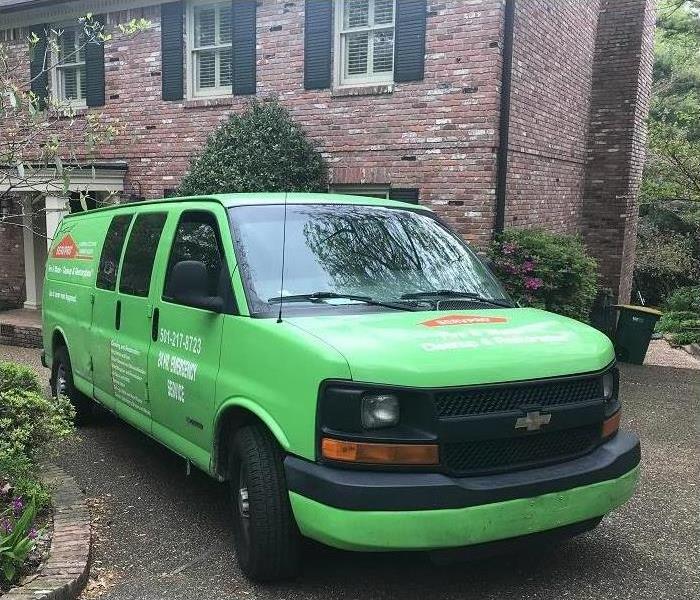 Each vehicle in our Green Fleet is stocked with equipment to dry your water damaged home. Call us today!
Each vehicle in our Green Fleet is stocked with equipment to dry your water damaged home. Call us today!
Importance of Fast Extraction in Water Damaged Homes
There are many reasons that water loss incidents should not get left to resolve themselves in your residence. With even moderate situations, damaging effects can still spread far beyond the source to affect multiple areas, materials, and contents. Additionally, affected areas include remote locations and spaces where homeowners cannot accurately determine the presence of saturation and moisture so that these effects can go unchecked and uncorrected without the expertise and equipment of skilled professionals like ours.
We know how vital it is to address damage in your home, beginning with water removal, as promptly as possible. While there are multiple tools at the disposal of our experienced SERVPRO team, for standing water scenarios it is often wise for our team to assess the severity of the situation before determining the best equipment to use. Our technicians arrive with the full measure of these options to immediately deploy the best tool for the job.
There are multiple reasons why water extraction and mitigation as a whole must get started as promptly as possible following a water loss incident. Without full knowledge of the severity and spread of the situation, homeowners can allow moisture and saturation to persist out of sight. This lingering dampness can facilitate microbial growth and can also directly damage structural elements and degrade construction materials.
Another reason why mitigation must begin as quickly as possible is the containment strategies that our SERVPRO professionals utilize. With these practices, physical barriers, and advanced equipment, we can stop the spread of water damage throughout your property while we get to work on removing pooling water and drying out the affected regions with air movers and dehumidifiers.
It is imperative for professionals like our SERVPRO of Breckinridge, Grayson, Meade and Hancock Counties team to get to work quickly on water damage that occurs in your house. We understand what equipment and tactics are necessary to make these damages “Like it never even happened.” Give us a call anytime at (270)580-2200.
Residential Water Toilet Overflow Is More Than a Messy Cleanup
8/17/2020 (Permalink)
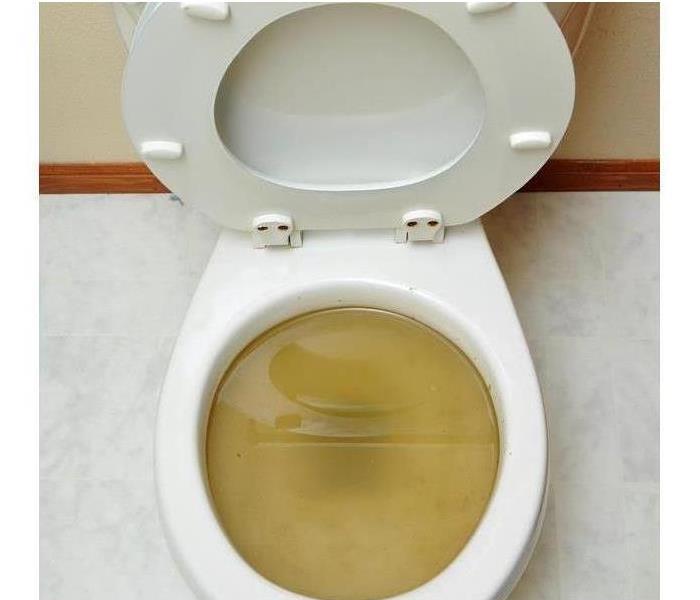 SERVPRO
SERVPRO
Dealing with an overflowing toilet in your Kentucky, home is frustrating, especially if the situation seems to frequently occur. Along with the mess it leaves behind, a flooded toilet can quickly lead to water damage in other areas of the home. As well as potentially being a costly endeavor, repair is made worse by the fact that the toilet could be a sign of a bigger sewer damage issue.
Toilet Problems
In most situations, there are three main reasons for a toilet overflowing:
Clogged Lines: This is the most frequent culprit, and a plunger often can fix the issues. In some cases, the clog may be too far down the line, a situation which may require calling a plumber. Frequent clogs may indicate it is time for a new toilet as well as serve as a reminder to only flush waste and toilet paper.
Blocked Vents: Plumbing fixtures store air and release it when flushing. Debris in vents can quickly lead to clogs that make toilets begin to drain more slowly or stop altogether.
Sewer Issues: The plumbing in your home is connected to the outside world. If the main line to the sewer is clogged or broken, it can cause sewage backup. Along with toilet issues, there may be leaks in the basement or around other drains.
Professional Cleanup
When the culprit is sewer damage, it means that the overflowing water is contaminated and should be handled by a sewage company. Considered black water, it contains potentially harmful pathogens and microorganisms. If the overflowing water had waste in it, it is best to contact a water remediation and restoration expert to handle the problem. Along with having the proper safety gear for the process, they have the know-how to detect additional damage and ensure that the cleanup is done properly. This guarantees your bathroom and affected areas are safe and clean.
While a toilet issue may seem like something that is easy to deal with, checking that there is no sewer damage is imperative before diving into cleanup.
Minimizing Flood Risk for Your Home
8/17/2020 (Permalink)
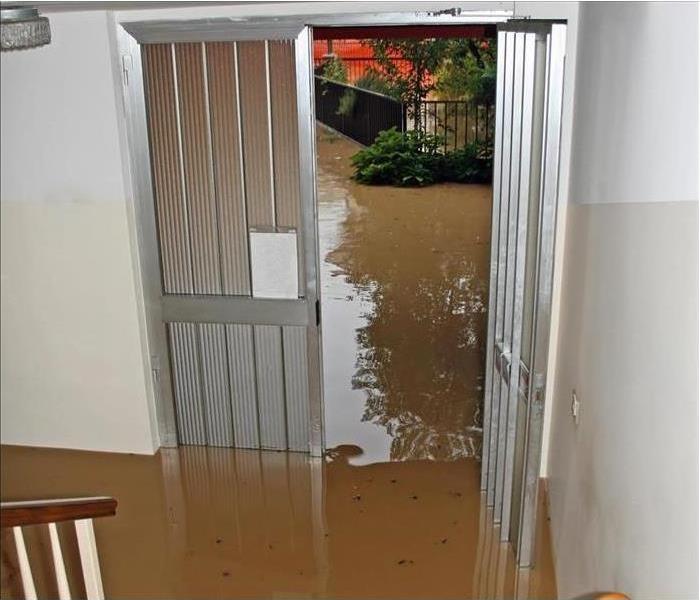 SERVPRO
SERVPRO
Water damage due to flooding is in the top three reasons for homeowners’ insurance claims. Many homeowners don’t realize how common it is to have a first-level or basement flood. This summary of flood risk and flood prevention may help you reduce your risk level.
Common Sources of Home Flooding
The following flood dangers are a few of the ways water can make its way into your home and cause damage:
- Internal sources such as broken pipes or leaking appliances
- Rivers or streams overflowing during severe storms
- Sump pumps failing
- Municipal failures, such as water main breaks and dam breaches
- Drainage malfunctions during severe storms
Whatever flood culprit threatens your home, it’s important to minimize your risk. Determining your home’s risk level is the first step.
Reducing Your Home Flood Risk
The best strategy for reducing your risk of a ground-level or basement flood is to arm yourself with information and preparation. A flood risk assessment for your home will tell you whether you should have flood insurance and will allow you to design a custom emergency preparedness plan. Your local flood remediation service or insurance agent can arrange a risk assessment for you.
If your property bears even a moderate risk for flooding, it’s prudent to purchase a flood insurance policy issued by the US Government. Your conventional homeowner’s policy will not cover home water damage unless the source of the flooded area was inside your home; if a water heater leak caused a basement flood in your Kentucky, home, your homeowner’s policy would likely cover you.
Based on your risk assessment, you can create a comprehensive flood prevention plan. In general, it’s a smart idea to schedule a walkthrough of your home with your family to identify emergency evacuation routes and discuss your plan. Signing up for local and national emergency notification services is also a good precaution.
A home flood risk assessment is your template for your emergency response plan. Creating and implementing the plan can mean the difference between a little water in the corner of your basement and extensive water damage.
Water, Water, Everywhere!
8/14/2020 (Permalink)
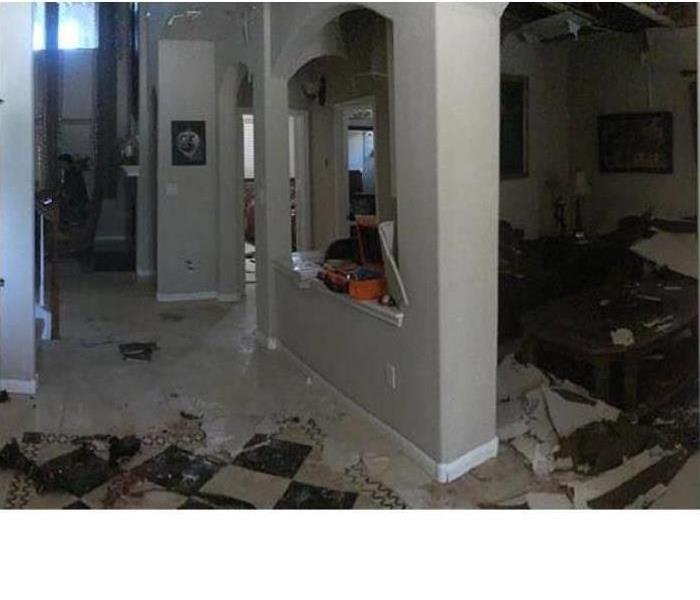 SERVPRO
SERVPRO
An Unwelcome Surprise
Imagine coming home from vacation, opening your front door, and seeing water on the floors and drywall scattered across your furniture and electronics as the ceiling is crumbling down. As you walk through your home, going up squishy stairs, you realize your whole home is flooded.
Your home is where you take refuge from the world. Home is where you're surrounded by memories. When your home is threatened by water damage, it can be a traumatic event. What do you do next?
When we asked SERVPRO customers to describe our team, the one word that kept coming up was “hero.” We are here to help, with compassion, expertise and urgency.
About SERVPRO of Breckinridge, Grayson, Meade and Hancock Counties
SERVPRO of Breckinridge, Grayson, Meade and Hancock Counties is a full-service restoration company. We provide emergency 24/7 mitigation services and complete reconstruction services. We make it “Like it never even happened.” So when an emergency situation arises in your business, give us a call and we’ll be there fast with the help you need.
SERVPRO of Breckinridge, Grayson, Meade and Hancock Counties specializes in the cleanup and restoration of commercial and residential property after a water damage event. Our staff is highly trained in property damage restoration. No matter what size disaster, from single story and a complete high-rise, rest assured our staff is equipped with the knowledge and resources to restore your property.
Let us help you minimize and prevent further water damage.
8/14/2020 (Permalink)
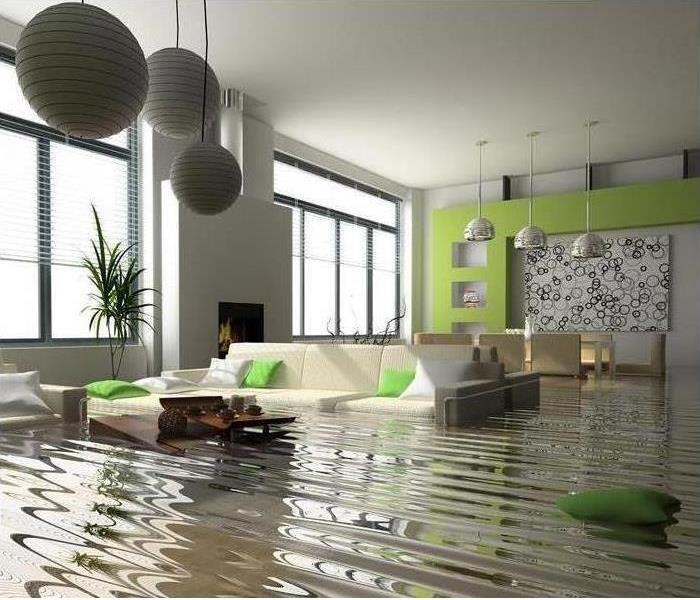 SERVPRO
SERVPRO
There’s no such thing as a small disaster, especially when you have water damage in your home. Water damage can affect the value of your property and if not cleaned properly, may cause major problems over time. Don’t leave your property to chance, call SERVPRO of Breckinridge, Grayson, Meade and Hancock Counties. Consider the following steps to help minimize damage or prevent further damage while waiting for help to arrive.
Damage from Clean Water
- Shut off the water source if possible or contact a qualified professional to do so.
- Remove as much excess water possible by mopping and blotting.
- Remove and prop up wet upholstery cushions for even drying.
- Place aluminum foil or wood blocks between furniture legs and wet carpeting.
- Wipe excess water from wood furniture after removing lamps and tabletop items.
- Move any paintings, art objects, computers, documents and other materials that are valuable or sensitive to moisture to a safe place.
- Do not enter rooms with standing water; electrical shock hazards may exist.
- Do not leave books, newspapers, magazines or other colored items on wet carpets as they may cause staining.
- Do not use your household vacuum cleaner to remove water, as there is potential for electrical shock or causing damage to the vacuum cleaner.
- Do not turn on ceiling fixtures if ceiling is wet; do not enter rooms where ceilings are sagging from retained water.
Damage from Contaminated Water
- Avoid all contact with sewage and items contaminated by sewage. Wash your hands thoroughly if you come in contact with contaminated items.
- Do not turn on the HVAC system if there is a possibility of spreading contaminated air. Do not use household fans to dry the structure; air flow could spread contaminants.
- Discard any food and/or products for personal hygiene and cleanliness if exposed to contaminated areas.
April Showers Bring May Flowers and More...
4/1/2020 (Permalink)
April showers help to bring us the most vibrant May flowers and we are so happy with this change of season. However, when April showers are more like torrential, relentless downpours we could face a flooded basement and other water damage causing costly repairs. Flooding generally occurs in the springtime as the result of heavy rains that cannot be adequately absorbed by the still thawing earth. Particularly formidable are the flash floods resulting from thunderstorms, swiftly melting snow and ice jams in creeks. Consider if more than one of these circumstances happens at the same time, you have the potential for a catastrophe with flooding waters and raging mudslides.
Homeowners you can take some simple precautions to secure your property and keep your possessions safe.
Elevate: Keep your furnace, water heater, electrical panels above predicted water levels to protect yourself from costly home replacements.
Install check valves: These valves close to prevent the backward flow of liquid and prevent water from backing up into the drains in your home.
Build barriers: Use sandbags to create flood walls to prevent or reduce flow of water into your home.
Waterproof the basement: Use a waterproofing compound to seal the walls of your basement.
Clean: Clean gutters, drains and downspouts for proper water flow.
Purchase flood insurance: Most standard homeowners' and business insurance policies unfortunately do no cover flood damage. In the event of a flood, you would be responsible for covering the full cost of repairs and replacing items damaged.
There is help close by should you experience an unfortunate event with your home or business. Contact SERVPRO of Breckinridge, Grayson, Meade & Hancock Co 270-580-2200. We are trained storm specialists who will come in and quickly get your home or business back to a safe and healthy environment. We have the specific training and certifications to handle your restoration needs provided by an Applied Microbial Remediation Specialist, a Water Damage Restoration Technician, and an Applied Structural Drying Technician. We provide emergency cleaning and restoration services 24 hours a day, 7 days a week—including all holidays. You can expect an immediate response time, day or night.
Do's and Don'ts for Water Damage
3/28/2020 (Permalink)
These DO's and DON'TS Emergency Tips for water damage will assist you in taking quick proper action to help you reduce damage and increase the chances of successful restoration before help arrives.
Sanitary Water-Clear
DO:
- Shut off the source of water if possible or contact a qualified party to stop the water source.
- Turn off circuit breakers for wet areas of the building when access to the power distribution panel is safe from electrical shock.
- Remove as much excess water as possible by mopping and blotting.
DON'T:
- Enter rooms with standing water where electrical shock hazards may occur.
- Enter affected areas if electrical outlets, switches, circuit breakers or electrical equipment are exposed to water. Always avoid electrical shock hazards.
- Leave books, newspapers, magazines or other colored items on wet carpets or floors as this may cause staining.
Contaminated Water-Gray, Black or Sewage
DO:
- Avoid all contact with sewage and items contaminated by sewage.
- Wash you're hands thoroughly after contact with contaminated items.
DON'T:
- Spread contaminated water by walking unnecessarily on damaged or wet areas.
- Turn on the HVAC system if there is a possibility of spreading contaminated air.
- Use household fans to dry the structure and spread contaminants.
- Use products for personal hygiene and cleanliness if exposed to the contaminated area.
Note: If exposed to harmful waste, OSHA recommends a post-exposure medical evaluation. Consult your local health department or physician.
How To Restore Your Belongings After Water Damage
7/25/2019 (Permalink)
Water in home settings can be devastating, whether it comes from leaking pipes or backed-up drains or toilets. While there may be nothing you can do to prevent your items from becoming waterlogged in the event of an unexpected water leak, there are some things you can do to restore your belongings after water damage occurs. Here are a few ways you can clean up various items in your Kentucky home.
1. Separate Items
Before you officially begin the cleanup process, separate your items into those that are porous and nonporous. Porous materials may include wood, paper, rugs and other types of fabric. Generally, these are more likely to harbor mold and bacteria from broken pipe water, so it’s important to clean them quickly. Nonporous items are usually much easier to clean, since they don’t absorb water and are less likely to harbor bacteria and mold.
2. Dry-Clean Non-Porous Items
Dry cleaning may be appropriate when removing light water residue from non-porous items in your home. Items can also be dry cleaned before floor restoration professionals come in and thoroughly clean your items.
3. Air-Dry When Appropriate
If you’re not dealing with hazardous water, such as sewage, it may be appropriate to gently air-dry most of your belongings. If possible, do so indoors unless the weather outdoors is ideal. You can increase the air flow inside your home with the use of open windows, air conditioners and fans.
4. Toss Dangerous Items
Depending on the nature of floodwater in home settings, it may be dangerous to keep saturated items. If there is a high likelihood of the floodwater containing harmful bacteria, it may be best to throw away contaminated objects. In other cases, professionals may be able to safely clean and salvage some of your valuables.
While you may be able to clean some of your belongings that water has damaged in your home, safety should always be your top priority whether you’re dealing with a broken pipe or a sewer backup. For help with dry-cleaning or salvaging contaminated items, it’s best to wait for professional help to arrive.
Preventing Water Damage During a Vacation: What You Can Do
7/9/2019 (Permalink)
 SERVPRO of Breckinridge, Grayson, Meade & Hancock Counties
SERVPRO of Breckinridge, Grayson, Meade & Hancock Counties
If you are going on vacation soon, you may be worried about what could happen if your Kentucky, home floods while you are away due to a water leak. You should try not to get to stressed out about this concern - there are several things you can do both to defend yourself against a flood and understand what options for remediation you would have if water pipe repair was required.
Prepare Yourself
If you know you are going to be away for some time, there are several things that you can do to help protect your home from a water-related disaster. Some of these actions include:
- Asking a friend, neighbor or family member to watch your house.
- Insulating external pipes (if it is cold outside).
- Cleaning and inspecting your sump pump, water hoses and gutters before you leave.
- Checking for leaks in water-based areas around your home.
- Turning off your water right before you go.
Taking action by following the advice above can help you avoid a flood and water pipe repair when you get home from your getaway.
What Might Happen
If a broken pipe floods your house while you are away, you may come home to find structural damage to various parts of your home. These could include floors, bathrooms and furniture, to name a few. Depending on how long the water has been sitting, it may be contaminated and require speedy removal.
Help is Available
You will hopefully be able to avoid a flood issue completely by following the preventative measures above. However, if you do come home from a relaxing trip only to find a flooded mess that will require water pipe repair, you will likely need to seek help from a water damage company, especially if highly contaminated water is involved. They will be able to understand what happened and what needs to be done to get everything back to a normal state as soon as possible.
Do You Have Water Dripping From a Light Fixture?
6/19/2019 (Permalink)
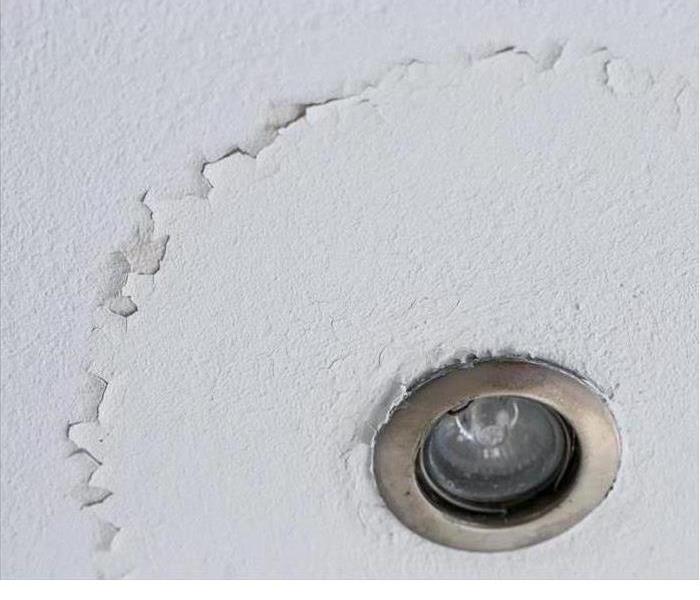 SERVPRO of Breckinridge, Grayson, Meade & Hancock Counties
SERVPRO of Breckinridge, Grayson, Meade & Hancock Counties
Water dripping from the ceiling is a serious and yet all too common problem. When that ceiling drip turns into water in a light fixture scenario, the situation can become hazardous. That is because electricity and water can be a dangerous combination. To ensure your family’s safety in Kentucky, call in a water mitigation team. While you wait for the team to arrive, there are four steps you can take to help get the job done quickly.
1. Utilities
Make sure the electricity, gas and water are turned off to the area affected by the leak. Water can conduct electricity from an active electrical line, and that can become a very dangerous situation as the current flows through the metal parts of the light fixture.
2. Announcing
Make an announcement to everyone in your home that there is water in a light fixture. You should probably also let them know the gas, water, and electricity will be turned off for an unknown number of hours. Once the water mitigation team arrives, and the source of the leak has been found, you can make another announcement regarding the required shutoff time.
3. Draining
Ceiling damage from water can sometimes pool and cause a protrusion in your ceiling. If that is true in your case, you may consider draining the area. With a bucket in hand, softly pierce the center of the sagging ceiling bulge with an item like a small wooden dowel. Be prepared for a deluge from the tiny hole.
4. Cleaning
Not only is it important to remove the water from the floor, but you may find it necessary to keep additional water from hitting your newly cleaned surface. Use a bucket to catch the leaking water if it is still dripping, and place towels around as necessary.
If the leaking water in a light fixture fell onto the carpet, you can make a request that your water mitigation team handle the water removal and disinfecting of the flooring area. Once repairs have been made, your home should be good-to-go.
3 Ways To Immediately Handle Sewage Damage in Your Home
6/10/2019 (Permalink)
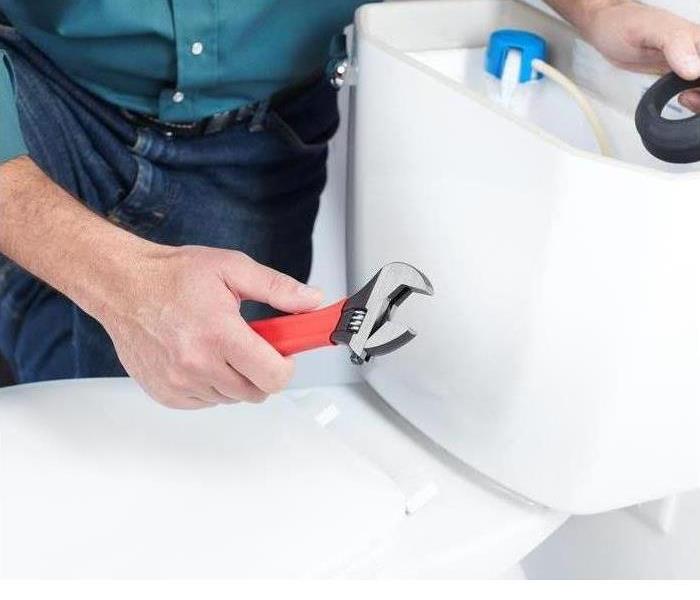 SERVPRO of Breckinridge, Grayson, Meade & Hancock Counties
SERVPRO of Breckinridge, Grayson, Meade & Hancock Counties
There are a number of things you’d prefer to never have to deal with in your Kentucky, home, and one of them is finding sewage damage. Whether you’ve come across a stubborn flooded toilet, a clogged drainage system or a full-blown flood from sewer backup, the end result is never pretty. If you’re wondering just how to go about treating and disinfecting your residence, here are three ways to instantly start managing sewer cleanup in a safe and responsible manner.
1. Avoid using the water supply system in your home if the damage is overwhelming.
You may be used to the occasional backed-up sink or toilet. However, if the damage is severe and the clog or disruption hasn’t been cleared yet, attempting to use any water in the home can result in even more destruction. It’s best to contact a professional team of water damage restoration specialists equipped to handle not only the immediate cleanup, but the necessary sterilization procedures afterwards to ensure your home is left safe and habitable.
2. If it’s still safe for you to be inside your home, wear protective clothing near the damaged areas.
When sewer cleanup is underway, keep your body covered in protective clothing and gear in order to prevent any contact with dirty, possibly infected water. Items such as goggles, rubber boots and gloves are best for keeping your skin and eyes covered, while a basic face mask can prevent you from breathing in any toxic fumes.
3. Open your windows and utilize fans to air out the obtrusive smell.
While experienced restoration specialists are Here to Help and are prepared to deodorize your home before their job is done, you can help release some of the bad odors by using fans and keeping your windows open throughout the day.
Be Ready for Any Stinky Situation
Dealing with sewer cleanup in your Kentucky, residence is never fun or easy, but with these ideas in mind to help recover after the fact, you’re one step closer to getting over the event as quickly as possible.
How SERVPRO Determines the Water Cleanup Processes for Your Home
5/28/2019 (Permalink)
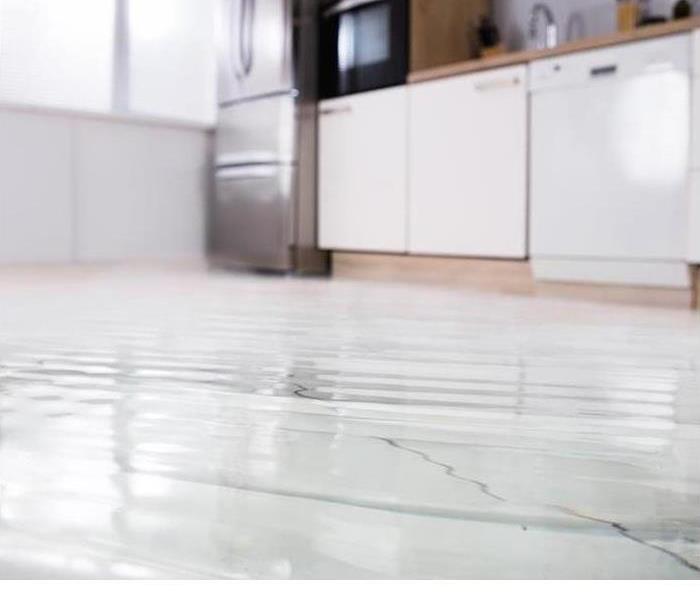 Various methods are used to clean up water damage in your home. Sub-floors, dry-walls, and carpet all have different cleaning processes.
Various methods are used to clean up water damage in your home. Sub-floors, dry-walls, and carpet all have different cleaning processes.
Water cleanup is a necessary process when we are restoring your property after the unfortunate water event. Usually, there are different types of items in a building, and we must select a cleaning method which does the work efficiently. For instance, the method we use to clean a carpet may be different from the one that we use when cleaning items such as subfloors and walls. We aim to return your property to its former condition, if not better.
Let us start by looking at the cleanup techniques we use when cleaning carpets in your water damaged property. To choose an appropriate cleaning method, we must begin by checking on the soiling level. In some instances, the dirt may be resting on the fiber tips, and in some situations, it might penetrate deep into the fibers. We also must check whether the fibers are stiff, sticky, or matted. Remember, we must clean the entire room, even if it is a small section of the carpet that is affected.
The carpet's soiling level can be heavy, moderate, or light. When our SERVPRO technicians are dealing with deep or heavy soiling levels, we may use rotary jet extraction and a deluxe pre-conditioner to rinse the area. We may use hot water extraction when cleaning moderate soiling levels and shampoo when we are attending to low pile carpets. For light soiling levels, we may use hot water extraction, bonnet and shampoo to clean.
While at the site, our SERVPRO technicians make a list of materials to clean. The degree of exposure to water and humidity determines the cleaning needs of a material. Once we clean the closets, we may come across clothing and other contents that require deodorizing and cleaning.
SERVPRO of Breckinridge, Grayson, Meade & Hancock Counties offers a stress-free cleaning and restoration process to residential and commercial property owners. Have a chance of working with our highly experienced technicians at any time of the day by calling 270-580-2200.
What You Can Do When Your Child Floods Your Bathroom And Hallway
5/28/2019 (Permalink)
Children are known to be curious, but sometimes that curiosity can leave you needing professional water cleanup services inside your home. When your child allows your bathroom tub to flood the floor of your bathroom, as well as the hallway, you may find yourself overwhelmed by the mess. However, it is essential for you to call for professional help.
It may be unwise to try and handle the water cleanup inside of your home by yourself, though it may seem tempting. While it is not always the case that you cannot clean up the mess yourself, it is wise to call for professional services when it comes to your carpeted hallway. It may even feel almost impossible to dry out your hallways by yourself because carpets can absorb so much water. In order to prevent further damages, such as microbial growth, it is wise to call for professionals who can make sure the moisture levels in your home are adequate.
Upon receiving your call, SERVPRO can send a team of our technicians to your home as fast as possible. Our professionals understand how important it's to handle water spills as quickly as possible to prevent further damages. We also know that the quicker we get the job done, the sooner you can get back to your everyday life.
When SERVPRO arrives at your home, our team of IICRC-certified technicians can begin the remediation process by using advanced trade tools. To address the puddles of water left behind in your bathroom, we can use wet/dry vacuums to remove the excess. To handle your soaked carpeting in the hallway, SERVPRO can use a tool called an extractor to simultaneously remove water while also providing heat to dry the fibers.
Should the walls inside your bathroom be damp from the water, SERVPRO can use further tools such as dehumidifiers and air movers. Using the tools together allows us to create an ideal environment that fosters evaporation. Once the moisture levels in your bathroom are back to an acceptable rate, we can leave you feeling "Like it never even happened."
Should your child cause your home to need urgent water cleanup services, never wait. Dial the number (270) – 580 - 2200 to get in touch with SERVPRO of Breckinridge, Grayson, Meade & Hancock Counties Day or night, we're here to help
What to expect from SERVPRO of Breckinridge, Grayson, Meade & Hancock Counties when you have a water loss.
3/28/2019 (Permalink)
When problems with plumbing cause excessive pooling it requires removal equipment that most homeowners just do not own. Whether it's a slow leak or a full-scale burst pipe, the after-effects of crawlspaces, sub floors and carpet pads that become saturated by water can cause lasting harm to a property's structure.
When it comes to removing water, we use pumps at first, before moving in with more precise wet/dry vacuums and extraction wands. SERVPRO of Breckinridge, Grayson, Meade & Hancock Counties technicians must pass a stringent training program before working in our franchises. Their training allows them to use advanced techniques to make sure moisture can be removed from even difficult to reach areas.
Floorboards can be notoriously difficult to dry, which is why we use flat lay drying techniques. A process by which a sheet is laid on the affected surface and air-circulation is applied. As the sheet inflates, water is drawn out and into the air. We have found this technique to be extremely useful in the removal of moisture from in between floorboards or gaps in your property's structure.
Carpets may be pulled up, pads replaced, and sub floors inspected to ensure every ounce of moisture has been removed. Once satisfied, we can place rapid air-movers into the affected area. These circulate hot air, evaporating moisture. It is part of a two-step process that guards against the risk of mold or mildew buildup after a leak. The second step is to place humidifiers into the affected area and remove the evaporated moisture from the air.
At the conclusion of service, our technician can remove all equipment as well as any materials that need discarding. We can then walk you through the affected area to show you where work has been carried out, where items have been restored and which need replacing. At SERVPRO of Breckinridge, Grayson, Meade & Hancock Counties we know replacing items can get expensive, so we work toward restoration rather than a replacement to keep costs as low as possible for our customers.
If you need urgent water removal, do not hesitate to call SERVPRO of Breckinridge, Grayson, Meade & Hancock Counties today! 270-580-2200
What Secondary Damage can occur after water damage in your home or commercial building?
7/25/2018 (Permalink)
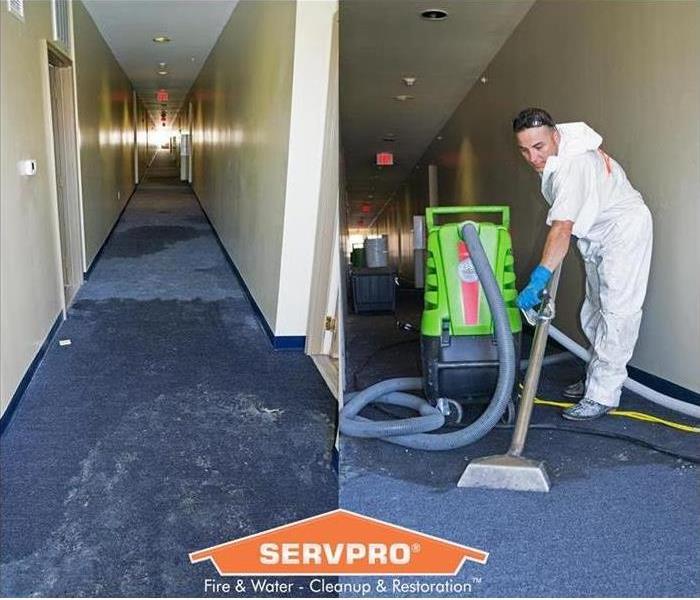 SERVPRO® of Breckinridge, Grayson, Meade & Hancock Counties 270-580-2200
SERVPRO® of Breckinridge, Grayson, Meade & Hancock Counties 270-580-2200
What Secondary Damage can occur after water damage in your home or commercial building?
After water leaks or flood damage, if not properly dried and treated, a home or business can develop mold from the moisture left on: wood, tile, carpeting, windows, concrete, and/or other materials/items that were affected. SERVPRO® of Breckinridge, Grayson, Meade & Hancock Counties strives to prevent secondary damage every time we remediate water damage. Building material and flooring are dried and treated to prevent mold and other allergens/contaminates using specialized equipment and cleaning products.
If water damage is not properly treated, the perfect environment is created for mold spores to grow in your home and to contaminate the air that is breathed.
Should you ever suffer water damage due to: a water heater leak, sink overflow, fire, refrigerator leak, excessive rain, storm damage, leaky roof, flood damage, or any other reason water has invaded your home or business, please know that SERVPRO® of Breckinridge, Grayson, Meade & Hancock Counties is here to help. Faster to Any Disaster
Commercial Fire Sprinkler Floods: 3 Ways to Protect Your Business
7/9/2018 (Permalink)
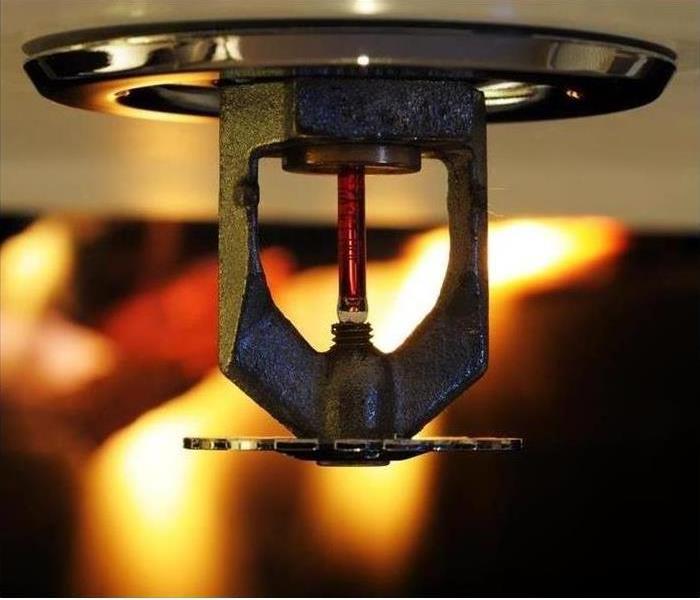 Flooding from a broken fire sprinkler system can be unexpected for you as a business owner
Flooding from a broken fire sprinkler system can be unexpected for you as a business owner
There are many different sources of flooding that can affect your Kentucky, commercial building. Some causes are common; however, even those that happen less often can be just as damaging. For example, you may not anticipate malfunctioning ceiling sprinklers to cause a flood but being prepared can help you protect your business in case the worst should happen. As you create a plan of action, there are a few strategies to consider that may reduce flood damage and allow your business to recover faster.
1. Know Where the Water Shutoff Valve Is
Trying to find your building’s water shutoff valve while the fire sprinklers are spraying water everywhere might prolong flooding and make matters worse. Locate your building’s main water valve ahead of time and map the fastest way to get to it. Give your managers a copy of the map so they can turn off the water if you are not there. The quicker you can cut off the water supply, the less serious the damage may be.
2. Have a Flood Damage Service on Call
Being able to call for help when your building suffers water damage can give you peace of mind, even during the worst of floods. Having a flood damage and restoration company on call that can perform mitigation services may reduce widespread problems that stem from a sprinkler malfunction. Experienced technicians can drain water from vulnerable areas and prevent water from spreading to adjacent rooms.
3. Be Aware of Your Insurance Coverage
If you have business interruption insurance, take the time to fully understand what your policy covers so there are no unpleasant financial surprises after a fire sprinkler flood. Have your agent’s number posted in several different locations and call him or her right away after an incident so the claim can be filed as soon as possible.
Flooding from a broken fire sprinkler system can be unexpected for you as a Kentucky, business owner. Being prepared for this or any type of water damage may help reduce the cost of mitigation and repair services, so you can recover quickly
Showers VS. Baths
6/19/2018 (Permalink)
 SERVPRO® of Breckinridge, Grayson, Meade & Hancock Counties 270-580-2200
SERVPRO® of Breckinridge, Grayson, Meade & Hancock Counties 270-580-2200
SERVPRO® of Breckinridge, Grayson, Meade & Hancock Counties is committed to doing our part to battle climate change and save our precious natural resources. Throughout the month we will be providing green tips and information to help you know how Recycle, Reduce and Reuse. A full bathtub requires about 70 gallons of water, while taking a 5-minute shower uses only 10-25 gallons. We are committed to making our community both here locally and globally better and stronger for this generation and ones to come. We are ready 24/7, 365 to help you, call us at 270-580-2000 so we can help make it “Like it never even happened.” when disaster from an upstairs neighbor’s bathtub overflows and you have water coming through your ceiling and making a mess in your condo or apartment. We are here to walk through the process with you from start to finish, helping to answer questions and guide you through the distressing situation
When It Floods: What To Do and What To Avoid
6/19/2018 (Permalink)
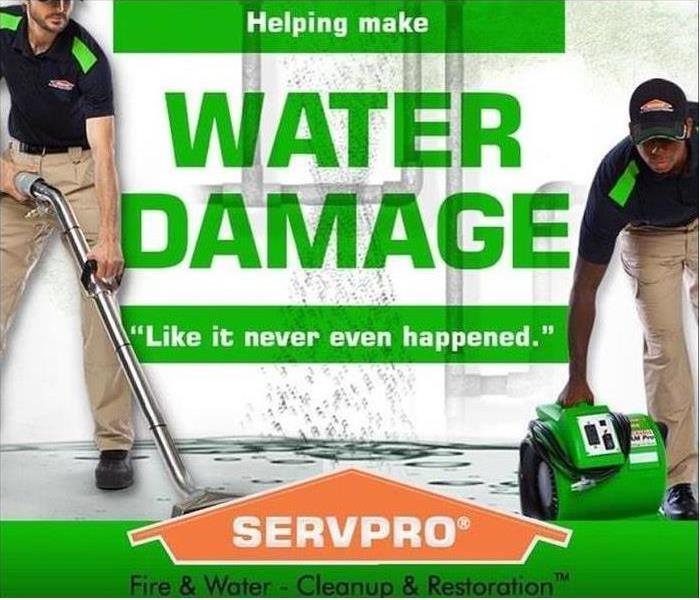 SERVPRO® of Breckinridge, Grayson, Meade & Hancock Counties. 270-580-2200
SERVPRO® of Breckinridge, Grayson, Meade & Hancock Counties. 270-580-2200
When your home floods, whether from a storm or a broken pipe, your first instinct is probably to start getting rid of water and cleaning up. To makes sure the repair process goes smoothly, however, there are a few steps you should follow. The first priorities are safety and documentation, and then you can call flood restoration specialists to lead in the cleanup efforts.
Safety First
Water in the home can render it temporarily uninhabitable, so there are a few things to look for when you return:
• Damage to water, sewer or power lines
• Warped surfaces, such as floors or walls
• Damaged foundation
• Visible cracks or holes in any part of your home’s structure
Try to avoid wading in standing water, as it could be electrically charged. Just in case, it is a good idea to wear knee-high rubber boots to absorb possible shocks. Even if the water looks clean, avoid contact with your skin, as it could be contaminated, especially if you suspect it might have come from a broken pipe or sewer line.
Document Damage
Your insurance adjuster is going to need to know the extent of the damage. Be vigilant about keeping your cell phone charged so you can take pictures for the report. Avoid cleaning before you document the damage, or your settlement could be smaller because the problem will seem smaller than it is. Once you have adequate documentation, call your insurer. The earlier you file a claim, the sooner you can get the money for repairs or reimbursement.
Cleanup
Rather than attempt to clean up the water yourself, it is a good idea to hire a professional. Experienced restoration specialists can help locate the cause of the problem, whether the flooding came from groundwater or a broken pipe. They also know how to overcome water damage so that you do not experience mold or mildew problems later
Spring showers bring… unexpected water damage.
5/15/2018 (Permalink)
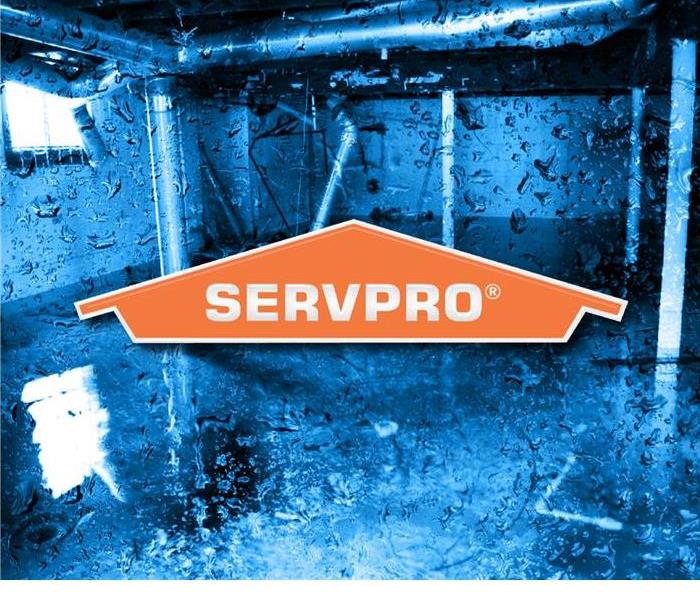 SERVPRO® of Breckinridge, Grayson, Meade & Hancock Counties. 270-580-2200
SERVPRO® of Breckinridge, Grayson, Meade & Hancock Counties. 270-580-2200
We hope spring brings you more flowers and fewer showers, but if you experience water damage, you know who to call. SERVPRO® of Breckinridge, Grayson, Meade & Hancock Counties is ready when a disaster occurs in your home or office, our experienced crews will assist in answering questions, bridging the gap between you and your insurance, insuring that all necessary parties have the information needed to complete the job faster, and get you back to life before. If your home or office should have a water damage from a sprinkler break, a dishwasher leak, or a washing machine overflow from the second floor (which you loved when you bought the house because it is so convenient). Know that you can trust us to help guide you through it, we are ready 24/7, 365 to help you at 270-580-2200.
What To Do Until Help Arrives
5/15/2018 (Permalink)
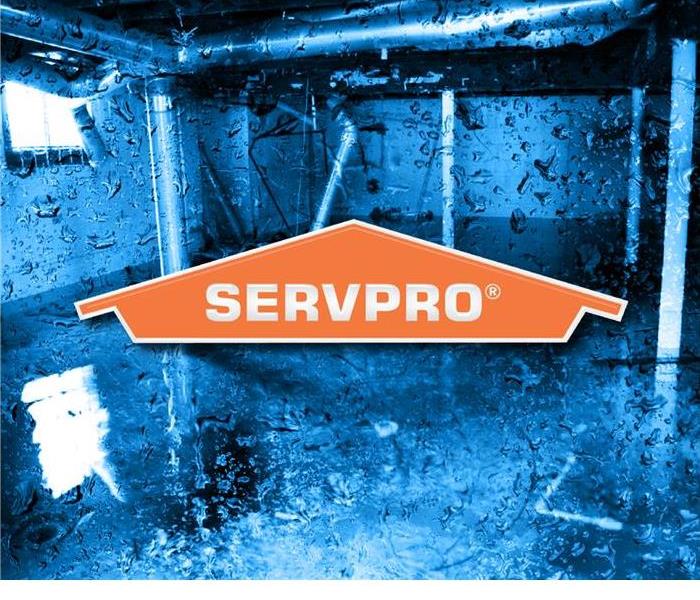 SERVPRO® of Breckinridge, Grayson, Meade & Hancock Counties. 270-580-2200
SERVPRO® of Breckinridge, Grayson, Meade & Hancock Counties. 270-580-2200
Many of us do not know the first steps to take in the event of water damage in our homes. SERVPRO has over 40 years of leadership and training in cleanup and restoration services. SERVPRO has put together a few Do’s and Don’ts to help in the event of water damage in your home.
Water Damage from Clean Water
DO:
- Shut off the source of the water as quickly as possible.
- Turn off any circuit breakers for wet areas of the building when access to the breaker box is safe from electrical shock.
- Remove as much excess water as possible by mopping & blotting.
- Wipe excess water from wood furniture after removing lamps and tabletop items.
- Place aluminum foil or wood blocks between furniture legs and wet carpet.
- Remove any documents, computers and other materials that are valuable or sensitive to moisture.
DON’T:
- Enter rooms with standing water where electrical shock hazards are at risk.
- Enter affected areas if electrical outlets, switches or circuit breakers are exposed to water/
- Leave books, newspapers. Magazines or other colored items on wet carpets or floors to cause staining.
- Leave oriental rugs or other colored rugs on wet wall-to-wall carpets to cause staining.
- Use your household vacuum cleaner to remove excess water. This could cause electrical shock or damage the vacuum cleaner.
- Use TVs or other appliances while standing on wet carpets or floors.
- Turn on ceiling fixtures if the ceilings are wet or enter rooms where ceilings are sagging from retained water
Satisfied Customer on Complete Water Restoration
2/21/2018 (Permalink)
 Before and After Photos from Bathroom Water Damage
Before and After Photos from Bathroom Water Damage
I recently had a water loss in my bathroom. SERVPRO of Breckinridge, Grayson, Meade & Hancock Counties was quick to respond. The staff explained each and every step of the process in a way that made me feel more confident that the job was going to be completed in a way that would meet my family's needs. I would highly recommend SERVPRO to anyone!
From: Emily in Leitchfield KY
A disaster in a home or business can be a very traumatic experience for people. We have a team of trained crew members who are experienced to help walk with you during the process and see what can be cleaned up and made like new.We love helping you make it “Like it never even happened."
Thank you for choosing SERVPRO® of Breckinridge, Grayson, Meade & Hancock Counties. Give us a call at 270-580-2200





 24/7 Emergency Service
24/7 Emergency Service











